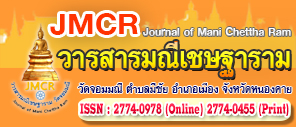DECISION-MAKING SKILLS OF SCHOOL ADMINISTRATORS AFFECTING TO TEACHERS’ TEAMWORK UNDER UDON THANI PROVINCIAL ADMINISTRATION ORGANIZATION
Keywords:
Decision-making skills, TeamworkAbstract
The purposes of this research are 1) to study the decision-making skills of school administrators under the Udon Thani Provincial Administrative Organization, 2) to study the teamwork of teachers under the Udon Thani Provincial Administrative Organization, 3) to study the relationship Between decision-making skills and teamwork of teachers and 4) to study the decision-making skills of school administrators that affect teamwork of teachers. The sample group consisted of 37 administrators and 99 teachers, totaling 136 people, obtained from stratified random sampling and then simple random sampling. The research instrument was an approximate scale questionnaire. The 5-level value has a confidence value for the entire questionnaire equal to 0.97. Statistics used in data analysis include frequency, percentage, mean, standard deviation. Simple correlation coefficient (Pearson Correlation coefficient) and stepwise multiple regression analysis.
The results of the research were as follows:
- Decision-making skills of educational institution administrators both in the overall picture and in each aspect, it was found that all aspects were at a high level.
- Teamwork of teachers in educational institutions both overall and in each aspect are at a high level.
- Decision-making skills of school administrators. There is a positive relationship with the teamwork of teachers in educational institutions. at a very high level ( =.998) with statistical significance at the .01 level.
- The decision-making skills of school administrators affect the teamwork of teachers in educational institutions, consisting of 6 areas: creation of control and evaluation systems alternative development, choosing the best option, recognizing and defining problems, implementation of decision results and implementing decision results with a multiple correlation value with the criterion variable equal to .997**
= 1.000 + 1.000 + 0. 991
Z = 1.000 + 1.000 + 0.991
References
บุญชม ศรีสะอาด. (2553). การวิจัยเบื้องต้น. กรุงเทพมหานคร: โรงพิมพ์สุวีริยาสาส์น.
วรัชญา นนทะสี. (2565). แนวทางการพัฒนาการทำงานเป็นทีมของสถานศึกษาขนาดเล็กสังกัดสำนักงานเขตพื้นที่การศึกษาประถมศึกษามหาสารคามเขต 2. ใน วิทยานิพนธ์ปริญญาครุศาสตรมหาบัณฑิต สาขาการบริหารการศึกษา บัณฑิตวิทยาลัย มหาวิทยาลัยราชภัฏมหาสารคาม.
ศรัญญู พงศ์ประเสริฐสิน. (2557). พฤติกรรมการตัดสินใจของผู้บริหาร กับประสิทธิผลโรงเรียน คาทอลิก สังกัดอัครสังฆมณฑล กรุงเทพมหานคร. ใน วิทยานิพนธ์ปริญญาศึกษาศาสตรมหาบัณฑิต สาขาวิชาการบริหารการศึกษา. บัณฑิตวิทยาลัย มหาวิทยาลัยศิลปากร.
สถาบันทดสอบทางการศึกษาแห่งชาติ. (2565). เรียกใช้เมื่อ 20 กรกฎาคม 2566 จากhttps://www.niets.or.th/th/.
Daft, R. L. (1999). Leadership theory and practice.Fort Worth, TX: Dryden Press.
Krejcie, R.V.,and Morgan D.W. (1970). Determining Sample Size for Research Activities.Educational and Psychological Measurement, 30 (3), 608 - 610.
Likert, R. (1967). The Method of Constructing and Attitude Scale, in Attitude Theory and Measurement. P.90-95. New York: Wiley & Son.
Stott, K. & Walker, A. (1995). Teams Teamwork & Teambuilding. Singapore: Prentice-Hall.




